2005 RENAULT MEGANE spark
[x] Cancel search: sparkPage 106 of 250
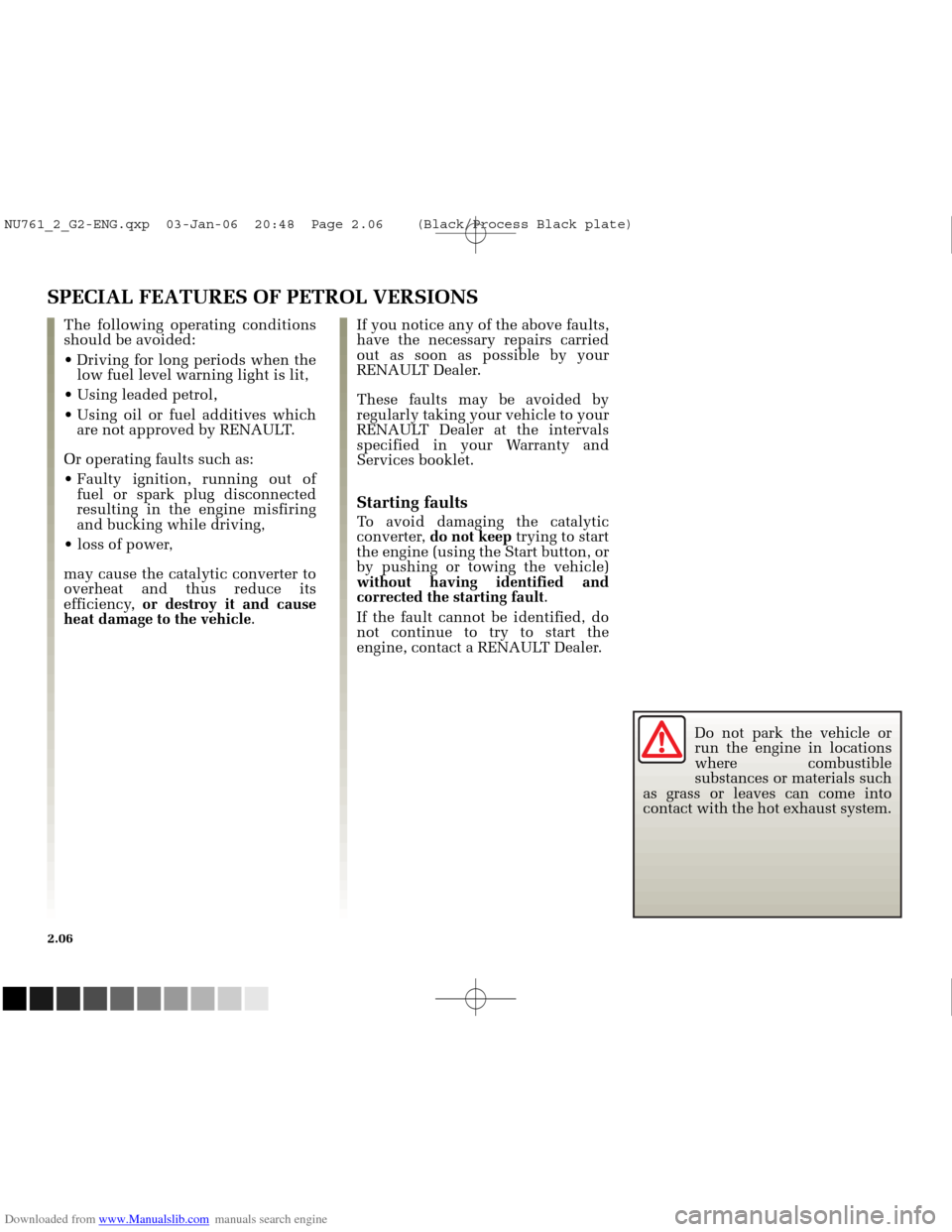
Downloaded from www.Manualslib.com manuals search engine
NU761_2_G2-FRA.qxd 4/11/05 10:48 Page 2.06
2.06
SPECIAL FEATURES OF PETROL VERSIONS
If you notice any of the above faults,
have the necessary repairs carried
out as soon as possible by your
RENAULT Dealer.
These faults may be avoided by
regularly taking your vehicle to your
RENAULT Dealer at the intervals
specified in your Warranty and
Services booklet.
Starting faults
To avoid damaging the catalytic
converter, do not keep trying to start
the engine (using the Start button, or
by pushing or towing the vehicle)
without having identified and
corrected the starting fault .
If the fault cannot be identified, do
not continue to try to start the
engine, contact a RENAULT Dealer.
The following operating conditions
should be avoided:
low fuel level warning light is lit,
are not approved by RENAULT.
Or operating faults such as:
fuel or spark plug disconnected
resulting in the engine misfiring
and bucking while driving,
may cause the catalytic converter to
overheat and thus reduce its
efficiency, or destroy it and cause
heat damage to the vehicle .
Do not park the vehicle or
run the engine in locations
where combustible
substances or materials such
as grass or leaves can come into
contact with the hot exhaust system.
NU761_2_G2-ENG.qxp 03-Jan-06 20:48 Page 2.06 (Black/Process Black\
plate)
Page 111 of 250
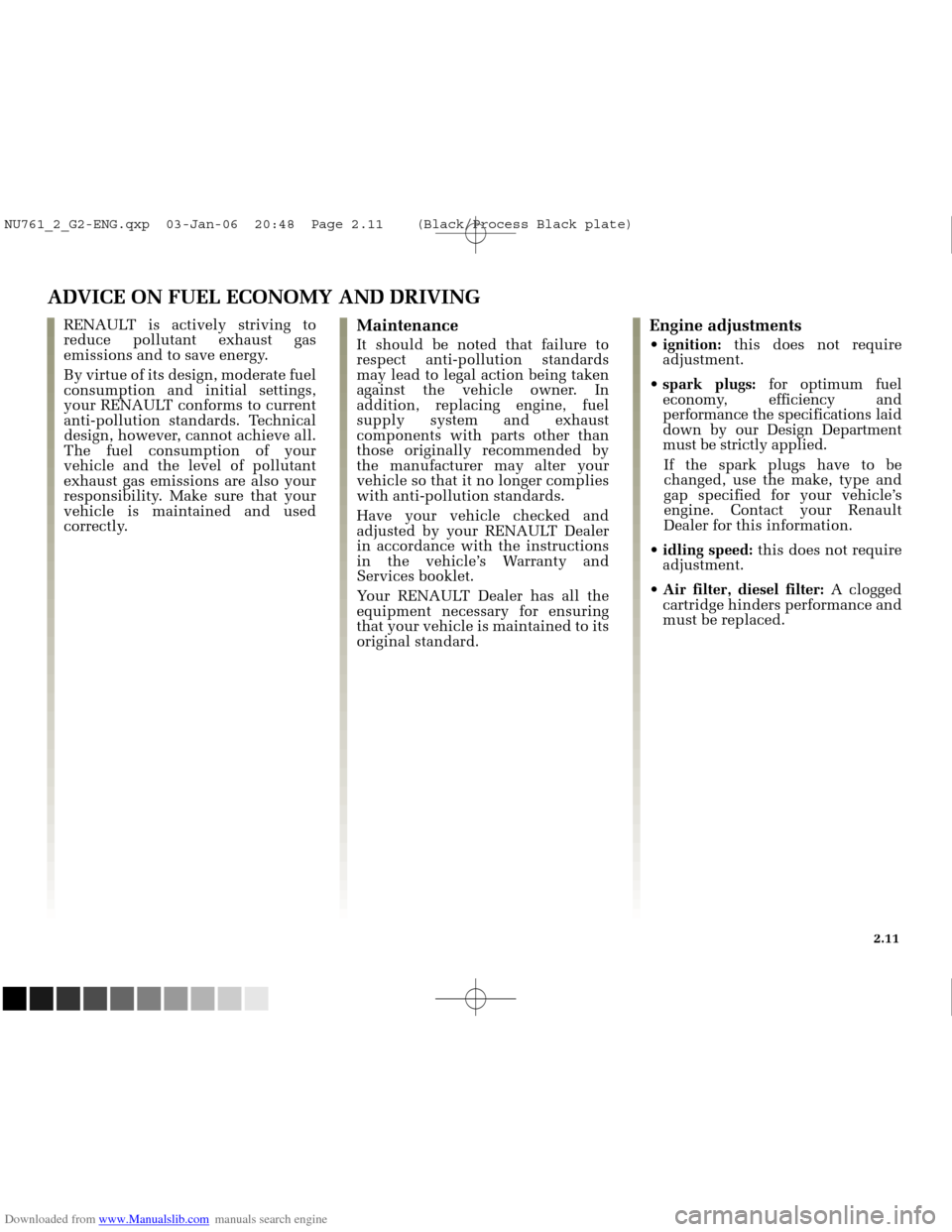
Downloaded from www.Manualslib.com manuals search engine
NU761_2_G2-FRA.qxd 4/11/05 10:48 Page 2.11
ADVICE ON FUEL ECONOMY AND DRIVING
Maintenance
It should be noted that failure to
respect anti-pollution standards
may lead to legal action being taken
against the vehicle owner. In
addition, replacing engine, fuel
supply system and exhaust
components with parts other than
those originally recommended by
the manufacturer may alter your
vehicle so that it no longer complies
with anti-pollution standards.
Have your vehicle checked and
adjusted by your RENAULT Dealer
in accordance with the instructions
in the vehicle’s Warranty and
Services booklet.
Your RENAULT Dealer has all the
equipment necessary for ensuring
that your vehicle is maintained to its
original standard.
Engine adjustments
• ignition: this does not require
adjustment.
plugs: for optimum fuel
economy, efficiency and
performance the specifications laid
down by our Design Department
must be strictly applied.
If the spark plugs have to be
changed, use the make, type and
gap specified for your vehicle’s
engine. Contact your Renault
Dealer for this information.
this does not require
adjustment.
A clogged
cartridge hinders performance and
must be replaced.
RENAULT is actively striving to
reduce pollutant exhaust gas
emissions and to save energy.
By virtue of its design, moderate fuel
consumption and initial settings,
your RENAULT conforms to current
anti-pollution standards. Technical
design, however, cannot achieve all.
The fuel consumption of your
vehicle and the level of pollutant
exhaust gas emissions are also your
responsibility. Make sure that your
vehicle is maintained and used
correctly.
2.11
NU761_2_G2-ENG.qxp 03-Jan-06 20:48 Page 2.11 (Black/Process Black\
plate)
Page 185 of 250
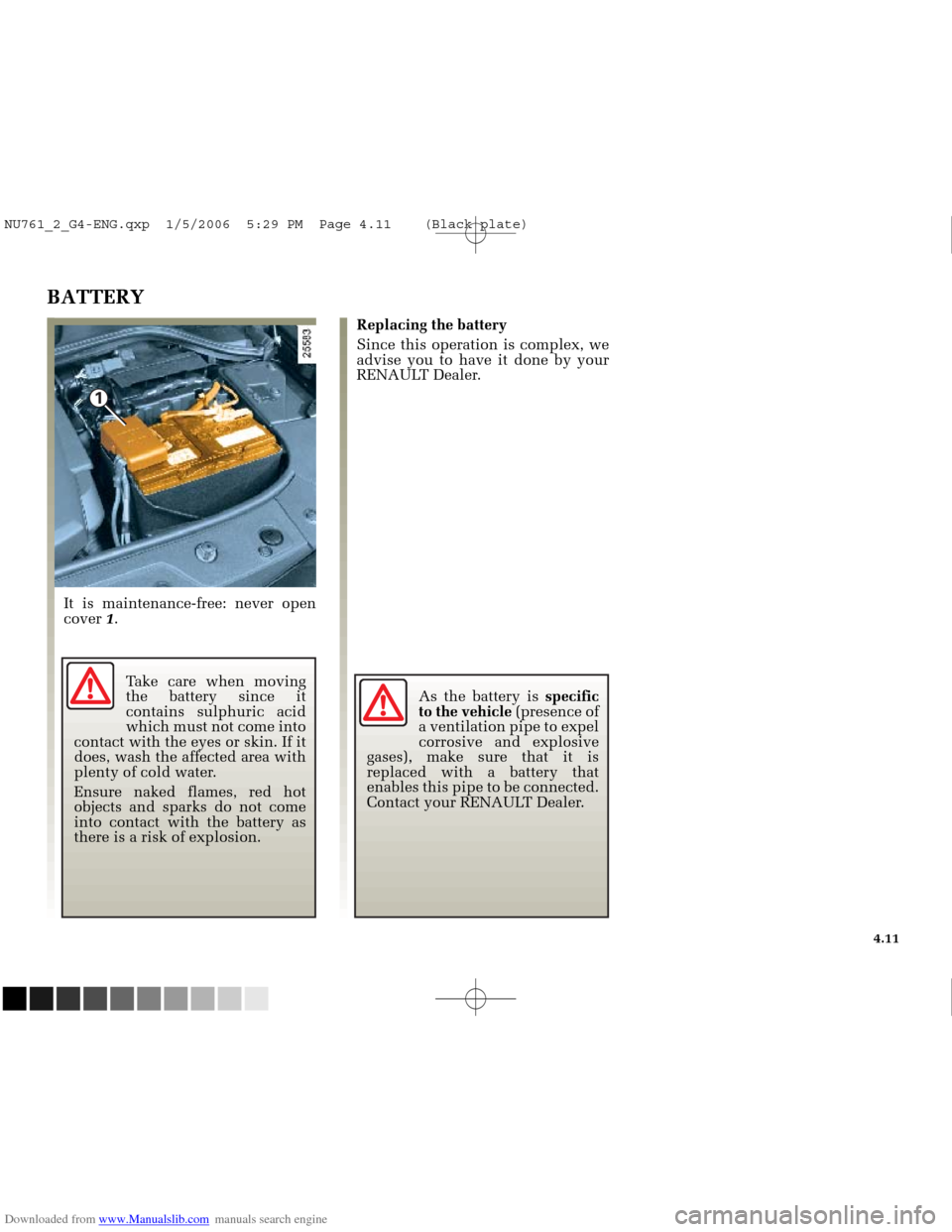
Downloaded from www.Manualslib.com manuals search engine
1
NU761_2_G4-FRA.qxd 14/11/05 10:11 Page 4.11
4.11
BATTERY
It is maintenance-free: never open
cover 1. Replacing the battery
Since this operation is complex, we
advise you to have it done by your
RENAULT Dealer.
Take care when moving
the battery since it
contains sulphuric acid
which must not come into
contact with the eyes or skin. If it
does, wash the affected area with
plenty of cold water.
Ensure naked flames, red hot
objects and sparks do not come
into contact with the battery as
there is a risk of explosion. As the battery is
specific
to the vehicle (presence of
a ventilation pipe to expel
corrosive and explosive
gases), make sure that it is
replaced with a battery that
enables this pipe to be connected.
Contact your RENAULT Dealer.
NU761_2_G4-ENG.qxp 1/5/2006 5:29 PM Page 4.11 (Black plate)
Page 208 of 250
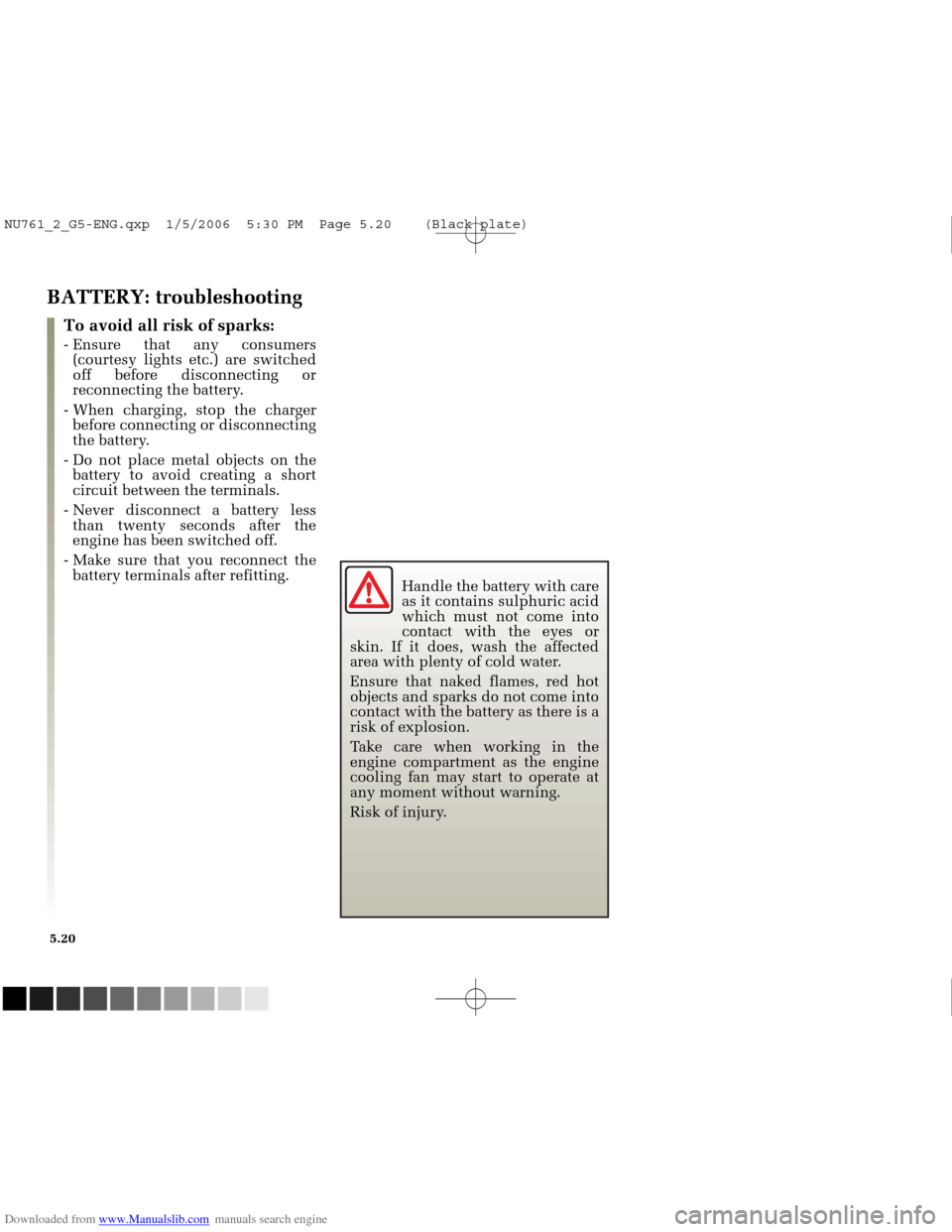
Downloaded from www.Manualslib.com manuals search engine
NU761_2_G5-FRA.qxd 4/11/05 11:09 Page 5.20
5.20
BATTERY: troubleshooting
To avoid all risk of sparks:
- Ensure that any consumers(courtesy lights etc.) are switched
off before disconnecting or
reconnecting the battery.
- When charging, stop the charger before connecting or disconnecting
the battery.
- Do not place metal objects on the battery to avoid creating a short
circuit between the terminals.
- Never disconnect a battery less than twenty seconds after the
engine has been switched off.
- Make sure that you reconnect the battery terminals after refitting. Handle the battery with care
as it contains sulphuric acid
which must not come into
contact with the eyes or
skin. If it does, wash the affected
area with plenty of cold water.
Ensure that naked flames, red hot
objects and sparks do not come into
contact with the battery as there is a
risk of explosion.
Take care when working in the
engine compartment as the engine
cooling fan may start to operate at
any moment without warning.
Risk of injury.
NU761_2_G5-ENG.qxp 1/5/2006 5:30 PM Page 5.20 (Black plate)
Page 209 of 250

Downloaded from www.Manualslib.com manuals search engine
NU761_2_G5-FRA.qxd 4/11/05 11:09 Page 5.21
5.21
BATTERY: troubleshooting (continued)
Connecting a battery charger
The battery charger should be
compatible with a battery with a
nominal voltage of 12 Volts.
With the engine switched off, it is
essential to disconnect the cables
connected to both battery terminals,
starting with the negative terminal .
Do not disconnect the battery when
the engine is running. Follow the
manufacturer’s instructions for the
battery charger you are using.
Only a well-charged and well-
maintained battery will have a long
and useful life and enable you to
start the vehicle’s engine normally.
The battery must be kept clean and
dry.
Have the battery’s charge status
checked regularly:
Especially if you use your vehicle for short journeys or for frequent
driving in town. When the external temperature
drops (in winter), the charge
decreases . In winter, only use
electrical equipment which is
really necessary.
Finally, you should understand that the charge decreases naturally
as a result of certain “permanent
electrical consumers” such as the
clock, After-Sales accessories, etc.
When many accessories are fitted to
the vehicle, have them connected
to + after ignition feed . In this case,
it is advisable to have your vehicle
fitted with a battery which has an
increased capacity. Contact your
RENAULT Dealer. If your vehicle is to be left stationary
for a relatively long time, disconnect
the battery or have it recharged
regularly, in particular during cold
weather. The equipment with a
memory, radio etc. will then have to
be reprogrammed. The battery must
be stored in a cool dry place,
protected from frost.
Special procedures may
be required to charge
some batteries. Contact
your RENAULT Dealer.
Avoid all risk of sparks which
may cause an immediate
explosion and charge the battery
in a well-ventilated area. Risk of
serious injury.
NU761_2_G5-ENG.qxp 1/5/2006 5:30 PM Page 5.21 (Black plate)
Page 221 of 250
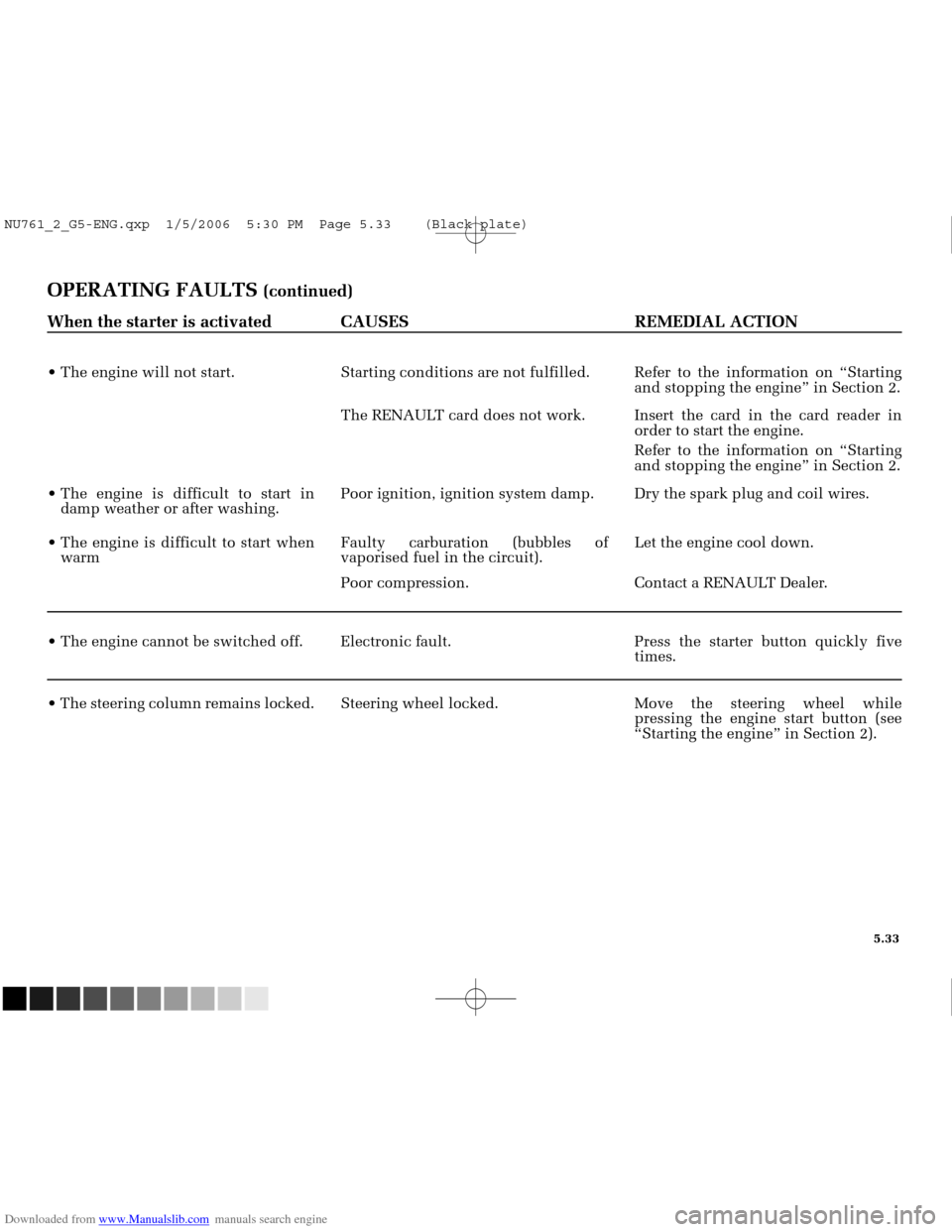
Downloaded from www.Manualslib.com manuals search engine
NU761_2_G5-FRA.qxd 4/11/05 11:10 Page 5.33
5.33
OPERATING FAULTS (continued)
When the starter is activated CAUSES REMEDIAL ACTION
The engine will not start. Starting conditions are not fulfilled. Refer to the information on “Starting and stopping the engine” in Section 2.
The RENAULT card does not work. Insert the card in the card reader in order to start the engine.
Refer to the information on “Starting
and stopping the engine” in Section 2.
The engine is difficult to start in damp weather or after washing. Poor ignition, ignition system damp. Dry the spark plug and coil wires.
The engine is difficult to start when warm Faulty carburation (bubbles of
vaporised fuel in the circuit). Let the engine cool down.
Poor compression. Contact a RENAULT Dealer.
The engine cannot be switched off. Electronic fault. Press the starter button quickly five times.
The steering column remains locked. Steering wheel locked. Move the steering wheel while pressing the engine start button (see
“Starting the engine” in Section 2).
NU761_2_G5-ENG.qxp 1/5/2006 5:30 PM Page 5.33 (Black plate)
Page 223 of 250
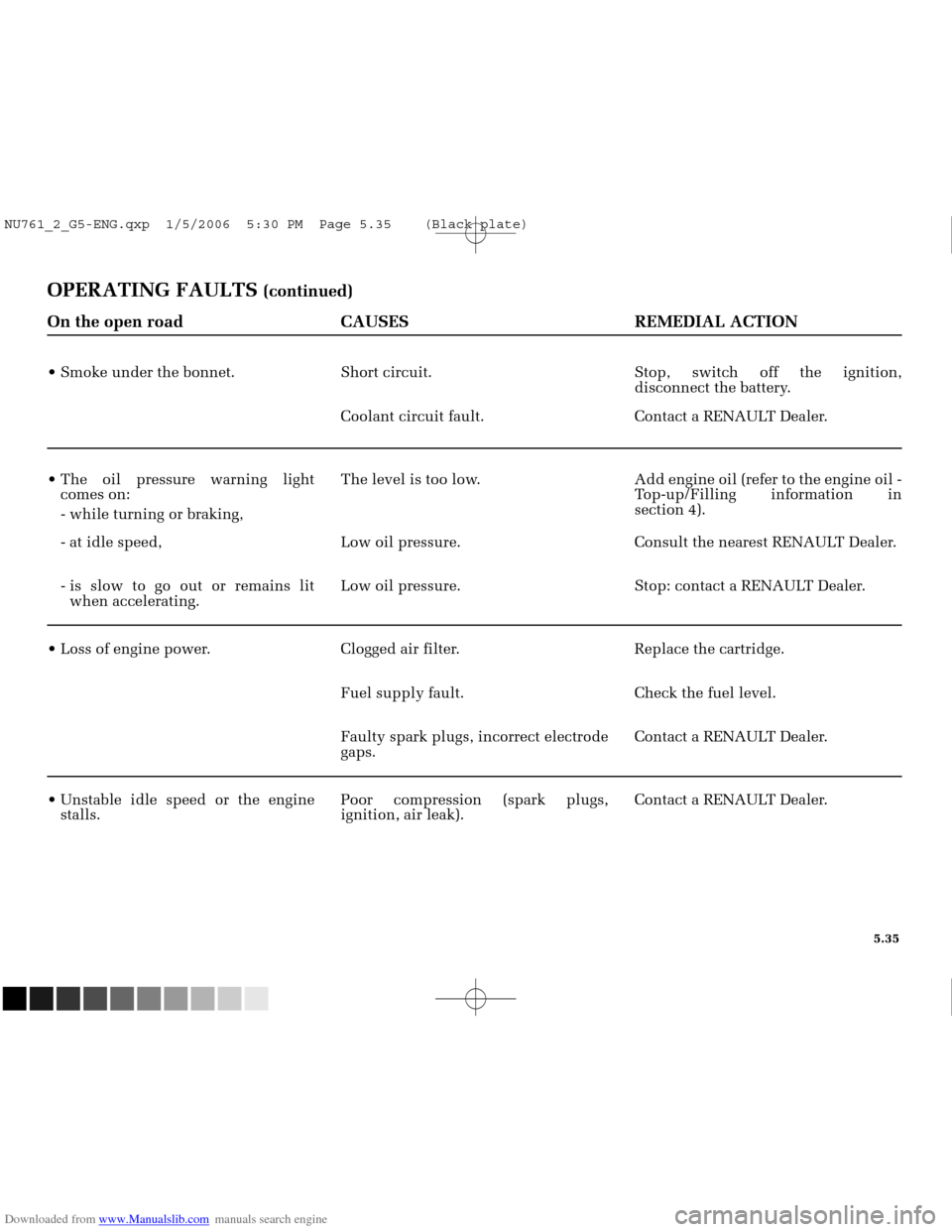
Downloaded from www.Manualslib.com manuals search engine
NU761_2_G5-FRA.qxd 4/11/05 11:10 Page 5.35
5.35
OPERATING FAULTS (continued)
On the open road CAUSES REMEDIAL ACTION
Coolant circuit fault. Contact a RENAULT Dealer.
Smoke under the bonnet. Short circuit. Stop, switch off the ignition,
disconnect the battery.
- is slow to go out or remains litwhen accelerating. Low oil pressure. Stop: contact a RENAULT Dealer.
- at idle speed, Low oil pressure. Consult the nearest RENAULT Dealer.
The oil pressure warning light
comes on:
- while turning or braking, The level is too low. Add engine oil (refer to the engine oil -
Top-up/Filling information in
section 4).
Faulty spark plugs, incorrect electrode
gaps.Contact a RENAULT Dealer.
Unstable idle speed or the engine stalls. Poor compression (spark plugs,
ignition, air leak). Contact a RENAULT Dealer.
Fuel supply fault. Check the fuel level.
Loss of engine power. Clogged air filter. Replace the cartridge.
NU761_2_G5-ENG.qxp 1/5/2006 5:30 PM Page 5.35 (Black plate)
Page 231 of 250
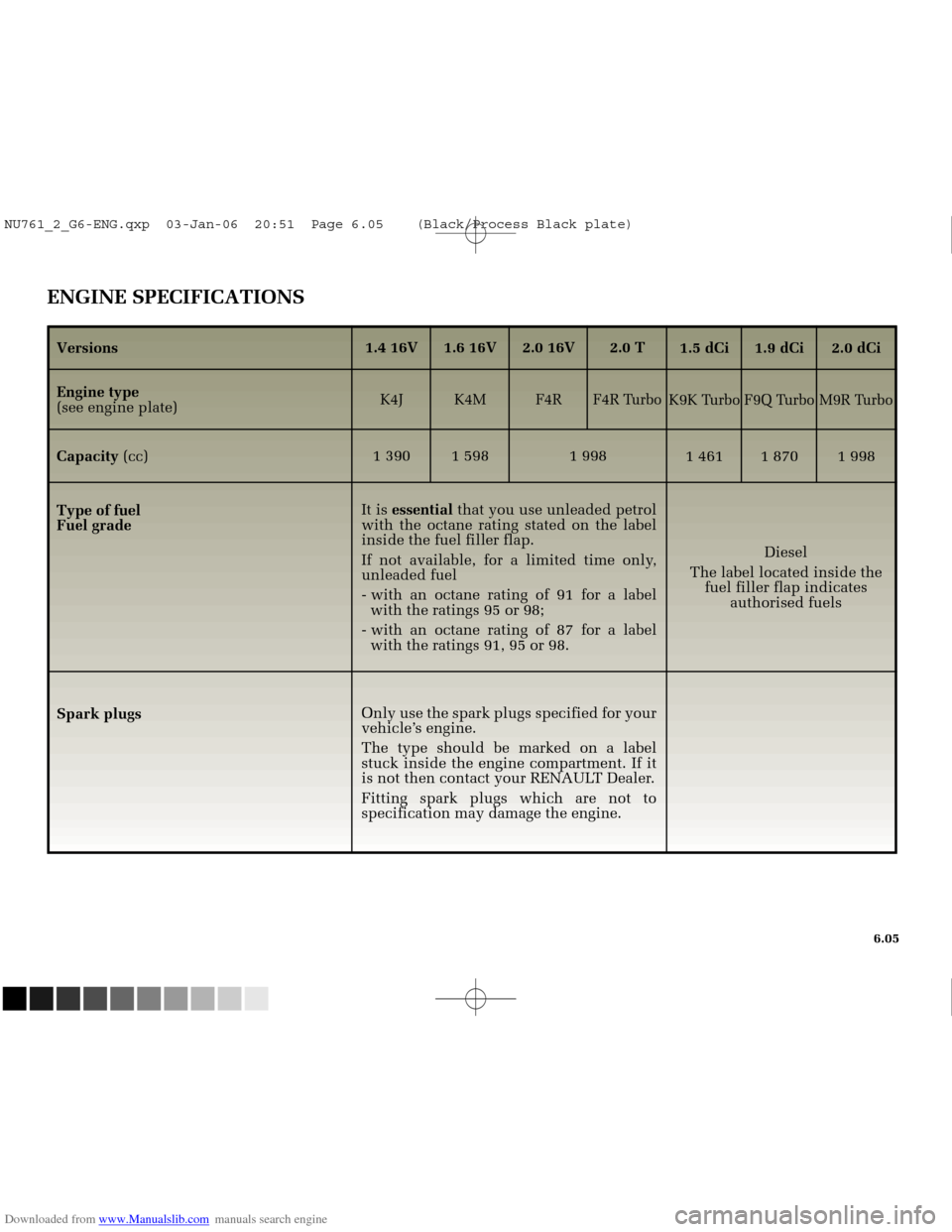
Downloaded from www.Manualslib.com manuals search engine
NU761_2_G6-FRA.qxd 4/11/05 11:11 Page 6.05
6.05
ENGINE SPECIFICATIONS
1.4 16V
K4J
1 3901.6 16V
K4M
1 5982.0 16V
F4R
1 9982.0 T
F4R Turbo
1.5 dCi
K9K Turbo
1 461 1.9 dCi
F9Q Turbo
1 870 2.0 dCi
M9R Turbo
1 998
It is essential that you use unleaded petrol
with the octane rating stated on the label
inside the fuel filler flap.
If not available, for a limited time only,
unleaded fuel
- with an octane rating of 91 for a label with the ratings 95 or 98;
- with an octane rating of 87 for a label with the ratings 91, 95 or 98. Diesel
The label located inside the fuel filler flap indicates authorised fuels
Only use the spark plugs specified for your
vehicle’s engine.
The type should be marked on a label
stuck inside the engine compartment. If it
is not then contact your RENAULT Dealer.
Fitting spark plugs which are not to
specification may damage the engine.
Versions
Engine type
(see engine plate)
Capacity
(cc)
Type of fuel
Fuel grade
Spark plugs
NU761_2_G6-ENG.qxp 03-Jan-06 20:51 Page 6.05 (Black/Process Black\
plate)